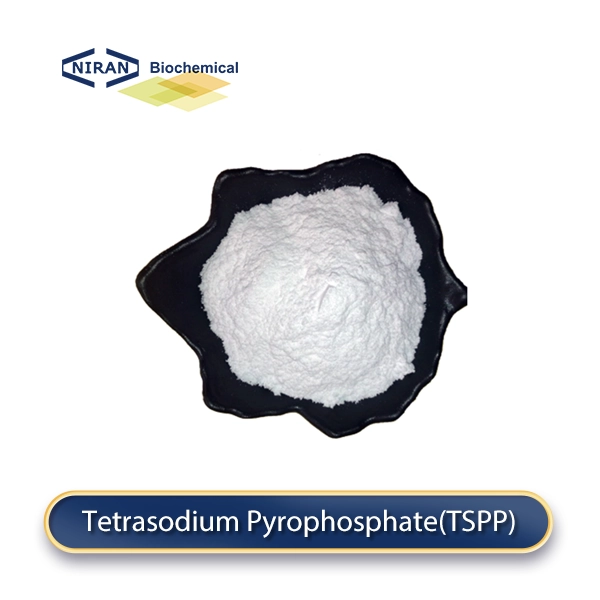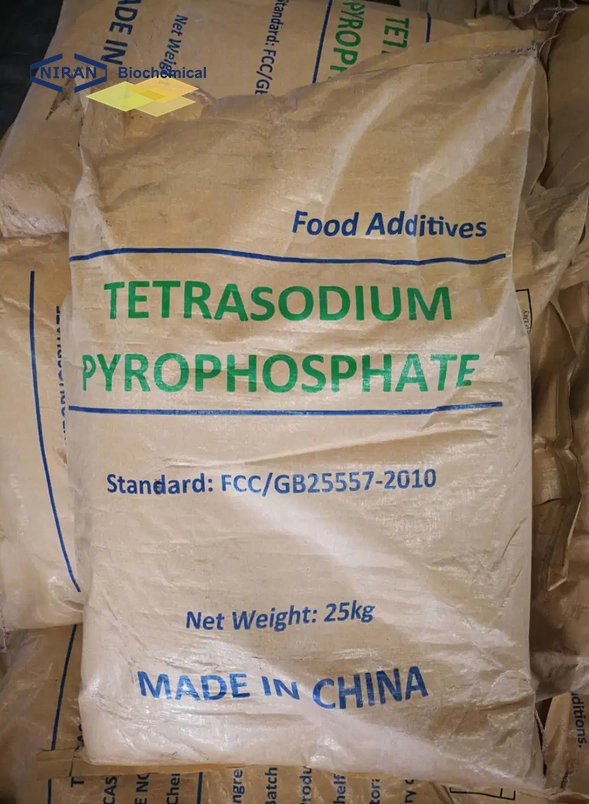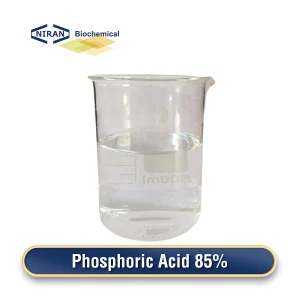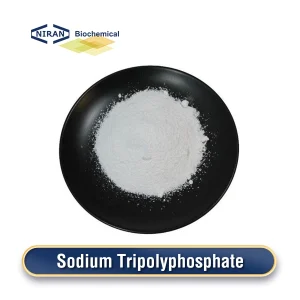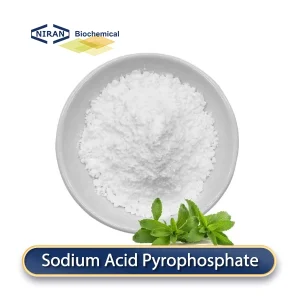Niran Biochemical
YOUR RELIABLE FOOD INGREDIENTS
Send Inquiry
Home » Products » Phosphates » TSPP-Tetrasodium Pyrophosphate
TSPP-Tetrasodium Pyrophosphate
- CAS: 7722-88-5
- Chemical Formula: Na4P2O7
- Certification: KOSHER, ISO, HALAL, FSSC22000, BRC, etc.
- Standard:
- MOQ: 1000KG
- Shelf Life: 2 Years
Inquire Product
Product Description
What is Tetrasodium Pyrophosphate?
Our Tetrasodium pyrophosphate comes in white crystalline, it is a chemical substance, also known as sodium pyrophosphate. Tetrasodium pyrophosphate is used as a buffer, chelating agent and surfactant in industry. In the food industry, it is often used as an emulsifier and stabilizer, and can also be used to adjust the acidity of food. In addition, tetrasodium pyrophosphate is also used to make detergents, cleaning agents and rust inhibitors.
Tetrasodium pyrophosphate is obtained by drying an aqueous solution of disodium hydrogen phosphate to obtain anhydrous disodium hydrogen phosphate, and then dehydrating and polymerizing at high temperature. There are two types: one-step method and two-step method. Drying and polymerization are completed in one device, which is called one-step method, and drying and polymerization are completed in two devices, which is called two-step method.
The one-step method has simple equipment and a short process, but the quality is not very stable. The two-step method has more complex equipment, a longer process, and more stable product quality. Sodium pyrophosphate used in the food industry mostly adopts the two-step method.
The reaction formula is:
Na2HP04·12H20→Na2HP04+12H20
2Na2HP04→Na4P207+H20
Related parameters:
| Items | Units | Specifications |
| Assay,(as Na4P2O7) | % | 96.5 Min. |
| pH(1% Solution) | 9.8~10.8 | |
| Water Insoluble, ω | % | 0.2 Max. |
| Arsenic(As) | mg/kg | 1 Max. |
| Heavy Metal | mg/kg | 10 Max. |
| Lead(Pb) | mg/kg | 1 Max. |
| Fluoride(F) | mg/kg | 10 Max. |
| Whiteness | % | 88 Min. |
| Bulk Density | g/cm3 | 0.60~0.8 |
| Loss on Ignition | % | 0.5 Max. |
| Orthophosphate | Pass test |
Recommended dosage:
| Food Name | Maximum usage(g/kg) |
| Meat products | 2-5 g/kg |
| Seafood | 1-3 g/kg |
| Dairy products | 2-4 g/kg |
| Carbonated beverages | 0.5-1 g/kg |
| Bread | 1-2 g/kg |
| Cured meats | 2-3 g/kg |
| Canned fruit | 0.5-1.5 g/kg |
| Seasoning oils | 0.5-1 g/kg |
| Salad dressings | 1-2 g/kg |
| Fruit drinks | 0.5-1.5 g/kg |
Tetrasodium Pyrophosphate has a wide range of uses
1. Food preservation
Tetrasodium pyrophosphate can reduce the surface tension of aqueous solutions and inhibit the growth and reproduction of microorganisms, thereby playing a role in preservation.
2. Increase the pH value of food
This substance can neutralize acidic substances and increase the pH value of food, making it more suitable for storage and consumption.
3. Chelate metal ions
Tetrasodium pyrophosphate can form stable complexes with metal ions in food to prevent them from oxidation or deterioration.
4. Improve food flavor
Tetrasodium pyrophosphate can react with macromolecules such as proteins to change their structure and properties, thereby affecting the taste and flavor of food.
5. Promote mineral absorption
Tetrasodium pyrophosphate releases phosphorus during digestion, which helps the body absorb phosphorus.
User asked questiones:
Q: What are the substitutes for tetrasodium pyrophosphate in the food industry?
A: The substitutes for tetrasodium pyrophosphate in the food industry include sodium tripolyphosphate, sodium hexametaphosphate, sodium dihydrogen phosphate, etc. These substitutes have their own advantages in water retention, emulsification, chelation and buffering, and are widely used in meat products, dairy products, beverages, canned foods and baked products. When choosing a specific substitute, it is still necessary to consider the food formula and functional requirements.
Q: Does the use of tetrasodium pyrophosphate affect the taste of food?
A: The use of tetrasodium pyrophosphate in moderation usually does not significantly affect the taste of food, but excessive use may cause bitterness or other unpleasant tastes.
Q: What is the market situation for food-grade Tetrasodium Pyrophosphate?
A: In 2024, the market for food-grade Tetrasodium Pyrophosphate (TSPP) shows a generally positive outlook both domestically and internationally.
Domestic Market (China):
The demand for food-grade TSPP remains strong, driven by its versatile food applications.
Prices have seen a moderate increase due to rising raw material costs and growing demand, particularly from the processed food sector.
International Market:
Globally, the TSPP market is projected to grow at a CAGR of 4.8% from 2020 to 2026, indicating robust demand across regions.
The North American and European markets are significant, with steady consumption in food and industrial applications.
Asia-Pacific, especially countries like India, Japan, and South Korea, shows the highest growth rate due to expanding food processing industries and increasing urbanization.

